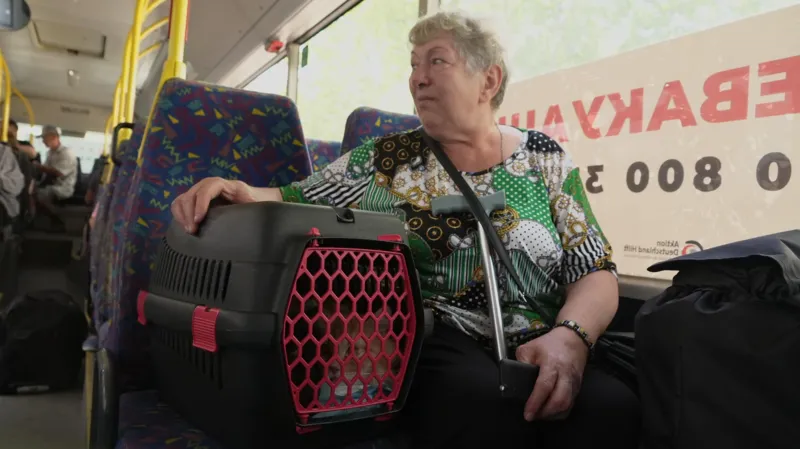In the eastern Ukrainian city of Pokrovsk, tension and fear are palpable. Streets that were once filled with the sounds of everyday life now echo with distant artillery fire and the rumble of military vehicles. For residents like Maria Honcharenko, the war has turned everyday life into a series of difficult choices and moments of sheer terror.
69-year-old Maria, who has spent most of her life in Pokrovsk, finally decided to leave her home. She held on in the hope that things might get better. But now, as the fighting draws closer and the sounds of explosions become more frequent, she knows it’s time to go. Holding a small bag and her two kittens, she is waiting for the evacuation bus. “Every time I hear the explosion, my heart stops,” she says, tears streaming down her face. She holds a simple, old mobile phone close to her chest, with the numbers of her loved ones saved on it.
Pokrovsk is now just 8 kilometers (5 miles) from the front line. Serhiy Dobryk, the head of the city’s military administration, describes how Russian forces target the town with everything from guided bombs to artillery. “Look what the Russians have done to us. I worked here for 30 years and now I’m leaving everything behind,” Maria says. Volunteers help them get on a bus. Trains no longer run from Pokrovsk; the railway station, once a hub of activity, is now silent.
A strategic target
Pokrovsk is no ordinary town – it is a vital transport hub in eastern Ukraine. If Russian forces capture it, they could cut off one of the key supply routes to Ukraine’s eastern front. That would force Ukrainian troops to retreat from nearby towns such as Chasiv Yar, pushing the front line closer to Kramatorsk. For Ukraine, losing Pokrovsk would mean losing almost the entire Donetsk region – a major setback in a war that has already gone on for too long.
The Ukrainian army has also suffered setbacks in other areas. Russia’s attempt to penetrate the Kursk region did not succeed in forcing Moscow to withdraw its troops from eastern Ukraine. Some military experts say the offensive boosted Ukrainian morale, but it also left strategic areas like Pokrovsk more vulnerable to Russian attacks. Recently, Russia claimed to have captured Novohrodivka, a village just 10 kilometers from Pokrovsk. While Kiev has not commented, sources have suggested that Ukrainian forces have indeed withdrawn from the area. The evacuation bus quickly filled up with more people, including a mother and her five-year-old daughter. This is their second evacuation – last year, they fled from a border town when Russia launched its full-scale invasion of Ukraine. A city under siege As the conflict escalates, Pokrovsk is fast becoming a ghost town. A few months ago, it was home to about 48,000 people. Now, half of them are gone. The city, once full of shops, banks and cafes, is now eerily quiet. Most businesses are closed, and the hospital has been evacuated. Outside the city, trenches are being dug as Ukrainian forces prepare for what’s to come.
“Pokrovsk is clearly a top priority for Moscow,” says Serhiy Dobryak. “The ratio of forces fighting in this direction is 10 to 1 in Russia’s favour.” The Russians have stepped up their attacks, recently attacking a substation in the city that left half of Pokrovsk without electricity and disrupted water supplies.
Despite these setbacks, Ukrainian forces have managed to halt Russian advances. Ukraine’s commander-in-chief Oleksandr Sirsky says the military has stabilized the front line on the northern flank of the Russian attack on Pokrovsk. But the southern flank remains the focus of fierce fighting. Lt. Col. Oleh Demyanenko, a battalion commander in the 110th Brigade, confirmed that Russian attacks are mostly concentrated there, where they are trying to capture the small town of Selidove.
On the front lines
Selidove, located southeast of Pokrovsk, has become another key point in the battle. At an artillery position of the National Guard’s 15th Brigade defending Selidove, soldiers are on high alert. As soon as unit commander Dmytro receives the coordinates for the new target, he gives the order, “Get ready for action!” The crew immediately springs into action, operating an old American M-101 howitzer – a cannon from World War II. Despite its age, the howitzer is still effective. “Fire!” Dmytro yells, and there is a deafening explosion as the cannon recoils, filling the air with smoke.
Dmytro, a 31-year-old commander, describes the situation as “very intense.” Russian forces attack in groups of 15 to 60 soldiers. “We fire up to 200 rounds a day to repel them,” he says. The Ukrainian soldiers know the risks. The more they fire, the more likely they are to attract Russian counterattacks. After every bombardment, they hide in dugouts to avoid counterfire.
